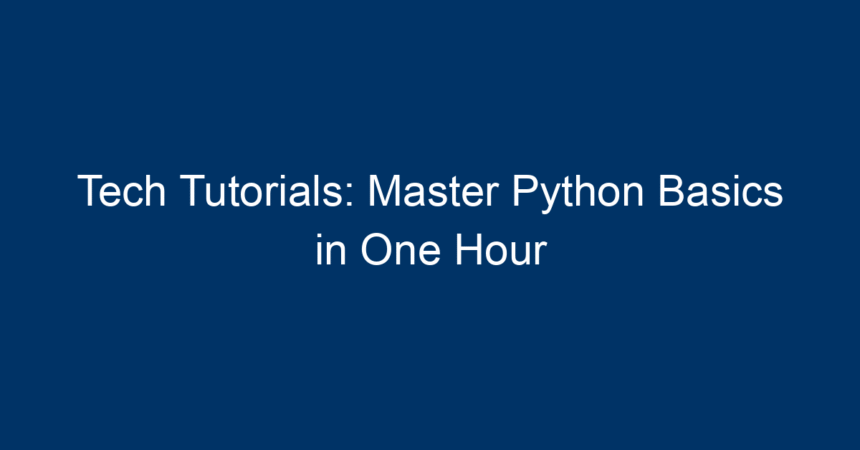In today’s tech-driven world, programming languages are the backbone of innovation and efficiency. Among these, Python stands out due to its simplicity and versatility. Whether you’re looking to automate tasks, analyze data, or build web applications, mastering Python is an invaluable skill. This article will serve as your comprehensive guide, helping you to grasp the basics of Python in just one hour through structured tech tutorials.
Why Learn Python?
Before we dive into the nitty-gritty of Python, let’s explore why learning this language is beneficial:
- Easy to Learn and Use: Python boasts a clean syntax that closely resembles English, making it more accessible for beginners.
- Wide Range of Applications: From web development to data analysis and artificial intelligence, Python is used in various domains, ensuring plenty of job opportunities.
- Large Community and Resources: With a vast developer community, you’ll find countless tech tutorials, forums, and libraries to enhance your learning experience.
- High Demand in Job Markets: Proficiency in Python often translates into better job prospects, making it a crucial addition to your resume.
Now, let’s get started with our tech tutorial on mastering Python basics!
Setting Up Your Environment
Downloading Python
- Visit the Official Website: Go to python.org.
- Select Your Version: Download the latest version of Python for your operating system (Windows, macOS, or Linux).
- Installation: Follow the installation instructions. Ensure you check the box that adds Python to your PATH. This option will make using Python in the command line convenient.
Choosing an IDE
An IDE (Integrated Development Environment) can significantly streamline your coding experience. Some popular IDEs for Python include:
- PyCharm: A powerful IDE with a free community version.
- Visual Studio Code: A versatile code editor with extensive extensions tailored for Python.
- Jupyter Notebooks: Ideal for data visualization and exploratory programming.
Feel free to select any IDE that suits your preference!
Python Basics: Your First Steps
Hello, World!
Let’s start with the classic first program. Open your IDE and create a new Python file. Write the following code:
python
print("Hello, World!")
This command outputs the text "Hello, World!" to the console— the first step in your Python journey.
Variables and Data Types
Understanding variables is crucial in programming. A variable stores data values, and in Python, you don’t need to declare the type explicitly. Here are some basic data types:
-
Strings: Text enclosed in quotes.
python
name = "Alice" -
Integers: Whole numbers without decimals.
python
age = 25 -
Floats: Numbers with decimal points.
python
height = 5.9 -
Booleans: True/False values.
python
is_student = True
Try it in your IDE and print the variables:
python
print(name, age, height, is_student)
Basic Operations
Python allows you to perform arithmetic operations easily. Here are some examples:
python
sum = 10 + 5
difference = 10 – 5
product = 10 * 5
quotient = 10 / 5
print(sum, difference, product, quotient)
Control Structures
Control structures allow you to dictate the flow of your program.
Conditional Statements
Conditional statements let you execute certain blocks of code based on conditions. Here’s a simple example using if statements:
python
num = 10
if num > 5:
print("Number is greater than 5")
else:
print("Number is less than or equal to 5")
Loops
Loops let you execute code repeatedly. The two main types are for loops and while loops.
-
For Loop: Iterates over a sequence (like a list).
python
for i in range(5):
print(i) -
While Loop: Repeats as long as a condition is true.
python
count = 0
while count < 5:
print(count)
count += 1
Functions: The Building Blocks
Functions are essential for structuring your code. They allow you to encapsulate reusable blocks of code.
Defining a Function
Here’s how you define and call a function in Python:
python
def greet(name):
return f"Hello, {name}!"
print(greet("Alice"))
Parameters and Return Values
Functions can take parameters and return values, making them flexible and powerful. Try creating a function that calculates the square of a number:
python
def square(num):
return num * num
print(square(4))
Working with Data Structures
Lists
Lists are used to store multiple items in a single variable.
python
fruits = [‘apple’, ‘banana’, ‘cherry’]
print(fruits[0]) # Outputs ‘apple’
Dictionaries
Dictionaries store data in key-value pairs, allowing for quick lookups.
python
student = {
‘name’: ‘Alice’,
‘age’: 25,
‘courses’: [‘Math’, ‘Science’]
}
print(student[‘name’]) # Outputs ‘Alice’
Tuples and Sets
Tuples are similar to lists but are immutable (cannot be changed), while sets contain unique items.
python
coordinates = (10, 20) # Tuple
unique_numbers = {1, 2, 3} # Set
Exception Handling
Errors are a part of programming, and handling them gracefully is a key skill.
python
try:
x = 10 / 0
except ZeroDivisionError:
print("Cannot divide by zero!")
Conclusion: Your Next Steps in Tech Tutorials
Congratulations! You’ve now covered the basics of Python in under an hour. You’ve explored installation, variable declaration, data types, control structures, functions, and data structures.
Actionable Insights
- Practice Regularly: The best way to reinforce your learning is through practice. Utilize platforms like LeetCode or Codecademy for hands-on exercises.
- Join Online Communities: Participate in forums like Stack Overflow or Reddit’s r/learnpython to ask questions and share your journey.
- Build Small Projects: Start simple with projects like a calculator or a to-do list app. Gradually increase complexity as your skills grow.
By focusing on these key areas and continuing your journey with tech tutorials, you’ll not only master Python basics but also set yourself on a path toward becoming a proficient programmer. Happy coding!




